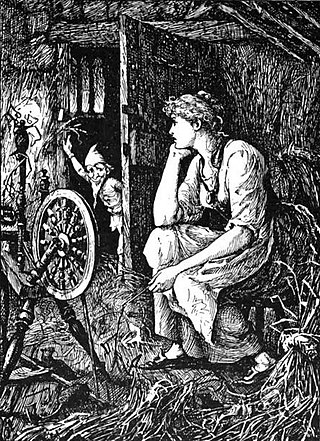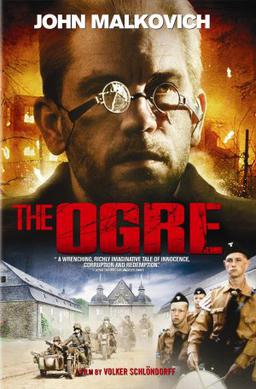"The Enchanted Doe" is an Italian literary fairy tale written by Giambattista Basile in his 1634 work, the Pentamerone . [1]
A king is desperate for a child. Following the instructions of a pilgrim, he has a young maiden prepare the heart of a sea dragon for his wife. Both women fall pregnant and birth identical boys. The child of the queen is named Fonzo and the child of the young maiden is named Canneloro.
The queen becomes jealous of how close the two boys are and tries to kill Canneloro. Canneloro survives the attempt, and resolves to leave. A despondent Fonzo begs him to leave a token. He leaves a fountain and myrtle plant that show whether he is well, in trouble, or dead.
Canneloro does well in the world, winning the hand of a princess. Bored, he goes hunting. He is trapped by an ogre who tricked him by transforming into a doe. Fonzo sees from the token that Canneloro is in trouble, and rescues him. Canneloro reflects that "Unhappy is he who corrects himself at his own cost".
A king, named Giannone, wished for a child. He was charitable towards beggars, hoping his generosity would win the favour of the gods and grant his wish. He continued until all his money was spent, but still he had no child. He shut himself into a tower, shooting at anyone who came near with a crossbow. One day, a pilgrim came. He told the king that if the queen ate the heart of a sea-dragon, prepared by a young maiden, she would have a child. The king had this done, and the queen gave birth to a boy. However, the young maiden, a servant, gave birth at exactly the same moment. The two boys were identical. The queen's child was named Fonzo, and the servant's child was named Canneloro.
The boys were inseparable, and the queen became jealous of Canneloro. She hated that Fonzo loved the child of a servant better than her. One day, Fonzo was making bullets for hunting with Canneloro. He left to get something, and while he was gone his mother came to look for him. Instead of her son, she found Canneloro, and thought to kill him. She took a hot bullet-mold and threw it at Canneloro. This left an ugly wound, but did not kill him. She prepared to throw it again, but was stopped by Fonzo returning. She left quickly, pretending she did nothing. Canneloro, hiding his wound from Fonzo, asked to be released from his service and go out into the world. He refused to tell Fonzo the reason. Fonzo tearfully agreed, but insisted that he leave a token. Canneloro stuck his dagger into the ground, opening a fountain. He told Fonzo that it would show him the course of Canneloro's life. If it ran clear, he was well. If it ran turbid, he was in trouble. If it went dry, he was dead. He then stuck his sword into the ground, growing a plant of myrtle. If it was green, he was well. If it was withering, he was in trouble. If it died, he too was dead. The two boys embraced, and Canneloro set out.
Canneloro had many adventures. One day he came across a tournament. The winner was to marry the princess Fenicia. He won, and married her. After some months, he became restless, and wanted to set out hunting. Fenicia's father, the king, told him not to. He warned him of a shapeshifting ogre, but Canneloro did not listen. The ogre, transformed into a doe, led Canneloro to its cave. It was a cold evening, so Canneloro sheltered inside and started a fire. The doe reappeared at the mouth of the cave, and asked Canneloro to let it warm itself by the fire. Canneloro agreed. The doe then claimed to be afraid, and convinced Canneloro to tie up his dogs, tie up his horse and bind his sword. The doe them transformed back into an ogre. The ogre captured Canneloro and imprisoned him in a pit.
Fonzo, who checked the fountain and myrtle twice daily, quickly noticed that the fountain was turbid and the myrtle withered. Worried about Canneloro, he quickly left home with his two enchanted dogs. He travelled far. Finally, he found the city where Canneloro had married. He found the city to be in mourning for Canneloro, who they thought dead. He went to court. There, Fenecia mistook him for Canneloro. She scolded him for going on a dangerous hunt, and mentioned the ogre. Canneloro concluded that Fonzo must be at the ogre's lair.
The next morning, the ogre lured him to the cave the same way it had lured Canneloro. However, seeing Canneloro's dogs and horses tied up, Fonzo did not fall for the trick. Instead, he killed the doe with his dogs. He found Canneloro, and freed him with great joy. They went back to Fenecia, who recognized Canneloro by his scar. After some time together, Fonzo returned home. Canneloro sent a message to his mother with Fonzo, asking her to come live with him and Fenecia. She did. The story ends with Canneloro recalling the saying: "Unhappy is he who corrects himself at his own cost" [2]

"Snow White" is a German fairy tale, first written down in the early 19th century. The Brothers Grimm published it in 1812 in the first edition of their collection Grimms' Fairy Tales, numbered as Tale 53. The original German title was Sneewittchen; the modern spelling is Schneewittchen. The Grimms completed their final revision of the story in 1854, which can be found in the 1857 version of Grimms' Fairy Tales.

The Langs' Fairy Books are a series of 25 collections of true and fictional stories for children published between 1889 and 1913 by Andrew Lang and his wife, Leonora Blanche Alleyne. The best known books of the series are the 12 collections of fairy tales also known as Andrew Lang's "Coloured" Fairy Books or Andrew Lang's Fairy Books of Many Colors. In all, the volumes feature 798 stories, besides the 153 poems in The Blue Poetry Book.
Snow-White-Fire-Red (Bianca-comu-nivi-russa-comu-focu) is a Sicilian fairy tale collected by Giuseppe Pitre and translated by Thomas Frederick Crane in Italian Popular Tales.

"The Twelve Brothers" is a German fairy tale collected by the Brothers Grimm in Grimm's Fairy Tales. Andrew Lang included it in The Red Fairy Book.

The Sea-Maiden is a Scottish fairy tale collected by John Francis Campbell in Popular Tales of the West Highlands, listing his informant as John Mackenzie, fisherman, near Inverary. Joseph Jacobs included it in Celtic Fairy Tales.

The Knights of the Fish is a Spanish fairy tale collected by Fernán Caballero in Cuentos. Oraciones y Adivinas. Andrew Lang included it in The Brown Fairy Book. A translation was published in Golden Rod Fairy Book. Another version of the tale appears in A Book of Enchantments and Curses by Ruth Manning-Sanders.

Ella Enchanted is a 2004 jukebox musical fantasy comedy film directed by Tommy O'Haver and written by Karen McCullah Lutz and Kirsten Smith, loosely based on Gail Carson Levine's 1997 novel of the same name. Starring Anne Hathaway and Hugh Dancy, the film is a satire of the fairy tale genre.

"The Two Kings' Children" is a German fairy tale collected by the Brothers Grimm in Grimm's Fairy Tales, tale number 113.

The White Deer is a 96 page children's novel written by James Thurber in 1945. It is a fairy tale about the quest of the three sons of King Clode – Thag and Gallow, the hunters, and Jorn, the poet – who are set perilous tasks to win the heart and hand of a princess who had once been a beautiful white deer, but lost her memories.

The Ogre is a 1996 French-German-British war drama film directed by Volker Schlöndorff and starring John Malkovich, Gottfried John, Marianne Sägebrecht, Volker Spengler, Heino Ferch, Dieter Laser and Armin Mueller-Stahl. It was written by Jean-Claude Carrière and Schlöndorff, based on the novel The Erl-King by Michel Tournier. The story follows a simple man who recruits children to be Nazis in the belief that he is protecting them.

The legend of The Twelve Sisters or The Twelve Ladies, known as Nang Sip Song (นางสิบสอง) or as Phra Rot Meri (พระรถเมรี) in Thai and រឿងភ្នំនាងកង្រី Puthisen Neang KongRei in Cambodia, is a Southeast Asian folktale, and also an apocryphal Jātaka Tale, the Rathasena Jātaka of the Paññāsa Jātaka collection. It is one of the stories of the previous lives of Buddha in which Rathasena, the son of one of the twelve women, is the bodhisattva.
Thep Sarm Rudoo (Thai: เทพสามฤดู; RTGS: Thep Sam Ruedu) is a 2005 Thai lakorn boran (Classic Play) based on Thai folklore which has been remade several times. This Thai television soap opera is one of the most popular in Thailand at 2005 with many famous actors and actress as the beautiful couple for Thai lakorn boran's fan. The plot is about a child of a king who can turn into 3 incarnations by changing season like turning to man for rainy season, turn to woman for cold season and turn to giant for dry season.

Cynon ap Clydno or in some translations Kynon or Cynan was an Arthurian hero from Welsh mythology. His quest to the Castle of Maidens and his subsequent trial against the Black Knight, serve as a prelude to the adventure of Owain and The Lady of the Fountain. Cynon is closely associated with Sir Calogrenant, who takes his role in other versions of the tale.

Tale of Tales is a 2015 European fantasy horror film co-written, directed and co-produced by Matteo Garrone and starring Salma Hayek, Vincent Cassel, Toby Jones, and John C. Reilly.
"Ill-Boding Patterns" is the thirteenth episode of the sixth season of the American fantasy drama series Once Upon a Time, which aired on March 19, 2017. In this episode, Gold must find a way to stop Gideon from going dark as he prepares to kill Emma, while Hook must find a way to hide the truth about Robert from her, and Wish Realm Robin seeks an ally to help escape Storybrooke. In the past, the legend of Beowulf and how he crossed paths with Rumplestiltskin is revealed.
The Story of The Farmer's Three Daughters is an Icelandic fairy tale collected by author Jón Árnason in his 1864 compilation of Icelandic tales and legends. It is related to the theme of the calumniated wife and classified in the Aarne-Thompson-Uther Index as type ATU 707, "The Three Golden Children".
The Story of Lalpila is an Indian folktale collected from the Baiga people by ethnologist Verrier Elwin. It is related to the cycle of the Calumniated Wife, and is classified in the international Aarne-Thompson-Uther Index as tale type ATU 707, "The Three Golden Children".
Again, The Snake Bridegroom is a Serbian folktale collected in the 19th century by Serbian philologist Vuk Karadžić, featuring the marriage between a human maiden and a husband in serpent guise.
Maria is the title given to a Filipino version of Cinderella collected by Fletcher Gardner and published in The Journal of American Folklore, in 1906. The story is related both to the international Cinderella narrative, as well as to the motif of the calumniated wife.